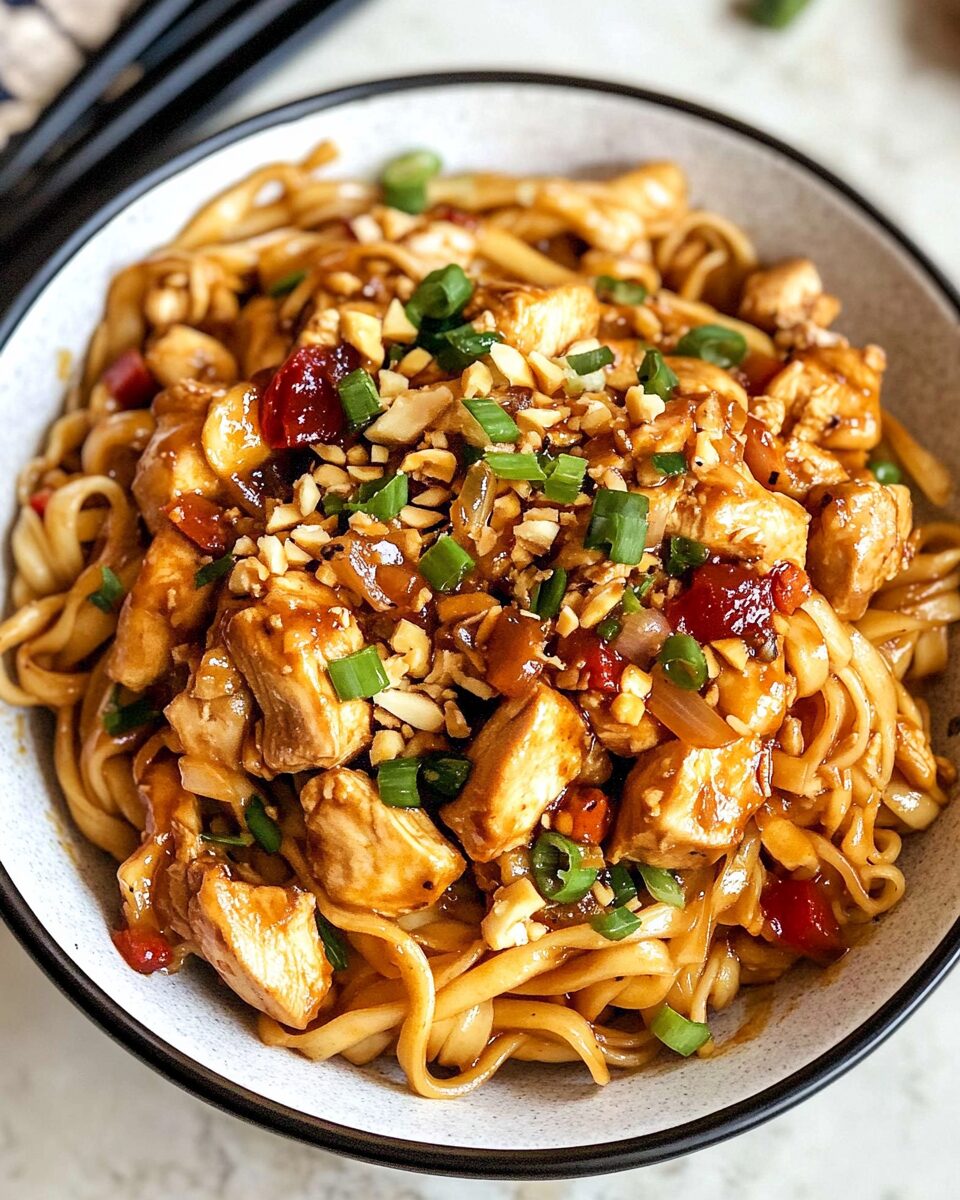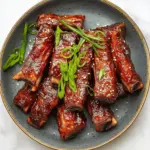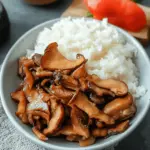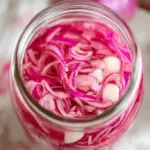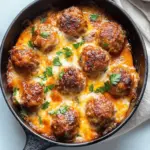Kung Pao Chicken Noodles is a perfect balance of savory, spicy, and slightly sweet flavors. This dish brings together tender chicken, crisp bell peppers, crunchy peanuts, and chewy rice noodles, all coated in a bold and flavorful sauce. The mix of textures makes each bite exciting, while the hint of Sichuan peppercorns adds a signature tingling heat that sets this dish apart.
Ideal for a quick weeknight dinner or meal prepping, this recipe is a healthier alternative to takeout. Plus, it’s easy to customize—swap in different proteins or veggies to suit your taste. Whether you love spice or prefer a milder flavor, this dish is a guaranteed crowd-pleaser.
Full Recipe
Ingredients:
- 8 oz rice noodles
- 2 boneless, skinless chicken breasts, diced
- 2 tablespoons soy sauce
- 1 tablespoon cornstarch
- 2 tablespoons vegetable oil
- 3 cloves garlic, minced
- 1-inch piece ginger, grated
- ½ cup roasted peanuts
- ½ red bell pepper, sliced
- ½ green bell pepper, sliced
- 1 small zucchini, sliced
- 3 green onions, chopped
- 1 teaspoon red pepper flakes (adjust to taste)
Sauce:
- 3 tablespoons soy sauce
- 1 tablespoon hoisin sauce
- 1 tablespoon rice vinegar
- 1 teaspoon sesame oil
- 1 tablespoon brown sugar
- ½ teaspoon crushed Sichuan peppercorns
Directions:
- Cook the rice noodles according to the package instructions. Drain and set aside.
- In a bowl, mix diced chicken with 2 tablespoons of soy sauce and cornstarch. Let it marinate for 10 minutes.
- Heat 1 tablespoon of vegetable oil in a large pan over medium-high heat. Add the marinated chicken and cook until golden brown. Remove and set aside.
- In the same pan, add the remaining 1 tablespoon of oil. Sauté the garlic and ginger until fragrant.
- Add bell peppers, zucchini, and green onions. Stir-fry for 3 minutes.
- Return the cooked chicken to the pan, then add roasted peanuts and red pepper flakes.
- Pour in the sauce ingredients and stir well. Cook for another 2 minutes.
- Toss in the cooked noodles, mix thoroughly, and serve hot.
Prep Time: 15 minutes | Cooking Time: 15 minutes | Total Time: 30 minutes
Kcal: 520 kcal | Servings: 4
Kung Pao Chicken Noodles: A Flavor-Packed Asian Delight
Kung Pao Chicken Noodles is a dish that brings together bold flavors, vibrant colors, and satisfying textures in one delicious bowl. With its origins in Sichuan cuisine, Kung Pao Chicken is known for its signature balance of spicy, savory, and slightly sweet flavors, along with the tingling sensation from Sichuan peppercorns. When paired with noodles, this dish transforms into a complete meal that is perfect for busy weeknights or a homemade alternative to takeout.
The History of Kung Pao Chicken
Kung Pao Chicken has deep roots in Chinese culinary history, specifically in the Sichuan province. It was named after Ding Baozhen, a Qing Dynasty official whose honorary title was “Gongbao” (hence the name “Kung Pao”). The dish was traditionally made with diced chicken, peanuts, and dried chili peppers, stir-fried in a flavorful sauce that featured the numbing and spicy properties of Sichuan peppercorns.
Over time, the recipe has evolved, and variations have emerged, particularly outside China. In Western adaptations, the spice level is often reduced, and additional ingredients such as bell peppers, zucchini, and cashews are sometimes added. The addition of noodles makes this version more filling while still retaining the signature Kung Pao flavors.
What Makes Kung Pao Chicken Noodles Special?
This dish stands out because of its rich and complex flavor profile. It combines multiple taste elements—spicy, salty, sweet, tangy, and umami—all in one dish. Here’s what makes it truly special:
- The Signature Spiciness – Kung Pao Chicken is known for its heat, which primarily comes from red chili peppers and Sichuan peppercorns. The latter adds a unique tingling sensation that is characteristic of Sichuan cuisine.
- The Crunch of Peanuts – Roasted peanuts add a nutty, crunchy texture that balances the softness of the chicken and the chewiness of the noodles.
- The Savory and Sweet Sauce – A combination of soy sauce, hoisin sauce, rice vinegar, and brown sugar creates a well-rounded sauce that clings perfectly to the noodles and ingredients.
- The Tender Chicken – The chicken is marinated and stir-fried to juicy perfection, making it a flavorful protein source.
- The Fresh Vegetables – Bell peppers, zucchini, and green onions not only add vibrant colors but also provide a refreshing contrast to the rich sauce.
How to Customize the Dish
Kung Pao Chicken Noodles is incredibly versatile, allowing you to tweak the recipe based on your preferences and dietary needs. Here are a few ways to customize it:
- Make It Vegetarian – Swap the chicken for tofu or mushrooms. Tofu absorbs the sauce beautifully and retains the dish’s classic flavors.
- Add More Heat – If you love extra spice, add more red pepper flakes or dried chili peppers. You can also drizzle some chili oil for an added kick.
- Use Different Noodles – While rice noodles work well, you can use egg noodles, udon, or even spaghetti if you don’t have traditional Asian noodles on hand.
- Swap the Nuts – If you’re allergic to peanuts, try cashews or almonds. For a nut-free version, sunflower seeds or sesame seeds can provide a similar crunch.
- Make It Healthier – Reduce the sugar and sodium by using low-sodium soy sauce and skipping the brown sugar. You can also load up on more vegetables to make it even more nutritious.
Why You’ll Love This Recipe
- Quick and Easy – Ready in just 30 minutes, making it perfect for busy schedules.
- Better Than Takeout – You control the ingredients, ensuring it’s healthier and fresher.
- Packed with Flavor – Every bite is a mix of savory, spicy, sweet, and crunchy goodness.
- Family-Friendly – You can adjust the spice level to suit everyone’s taste.
- Great for Meal Prep – Store leftovers for a delicious next-day lunch or dinner.
Tips for Making the Best Kung Pao Chicken Noodles
To achieve the best results, follow these simple tips:
- Marinate the Chicken – Letting the chicken sit in soy sauce and cornstarch makes it more tender and flavorful when stir-fried.
- Use High Heat – Stir-frying works best over high heat to quickly cook the ingredients while maintaining their texture.
- Cook the Noodles Properly – Don’t overcook the noodles, as they will continue to cook slightly when mixed with the sauce.
- Add Peanuts Last – To maintain their crunch, add the peanuts at the end of cooking.
- Balance the Sauce – Taste and adjust the sauce as needed—add a bit more sugar if it’s too spicy or more vinegar if it needs a tangier kick.
Serving Suggestions
Kung Pao Chicken Noodles is a complete meal on its own, but you can pair it with other dishes to create a full Asian-inspired feast:
- Egg Drop Soup – A comforting soup that balances the spice of the noodles.
- Spring Rolls – Crispy and light, these make a great appetizer.
- Steamed Dumplings – A classic side dish that adds variety to your meal.
- Garlic Bok Choy – A simple vegetable side to add freshness to the dish.
- Jasmine Rice – If you want to stretch the dish further, serve it over rice instead of noodles.
How to Store and Reheat
If you have leftovers, here’s how to store and reheat them for the best results:
- Refrigerate – Store in an airtight container in the fridge for up to 3 days.
- Reheat on the Stovetop – Add a splash of water or soy sauce to refresh the noodles and heat over medium heat until warmed through.
- Microwave – Heat in short intervals, stirring in between to ensure even heating.
- Avoid Freezing – Noodles tend to become mushy when frozen and reheated, so it’s best to eat this dish fresh.
Conclusion
Kung Pao Chicken Noodles is the ultimate fusion of bold Sichuan flavors and comforting, slurp-worthy noodles. It offers a perfect mix of spice, savory goodness, and satisfying textures, making it a must-try for anyone who loves Asian cuisine. This homemade version allows you to enjoy the dish with fresh, wholesome ingredients while skipping the unhealthy additives often found in restaurant takeout.
Whether you’re cooking for yourself, your family, or a dinner party, this recipe is a guaranteed hit. Plus, with its easy adaptability, you can tweak it to fit your dietary preferences while still keeping the core essence of Kung Pao Chicken.
Give this dish a try and experience the magic of Kung Pao flavors with every bite. Once you’ve mastered it, you may never need to order takeout again!

